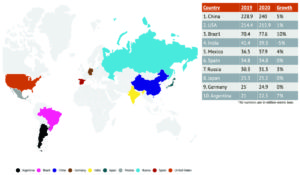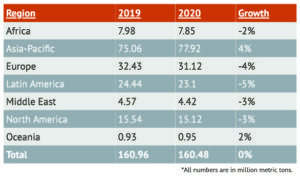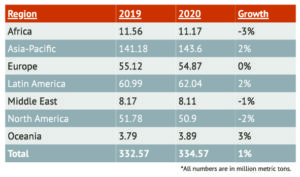The 2021 Global Feed Survey representing 142 Countries, was conducted by Alltech – both quantitatively and qualitatively and the analysis evaluates country, regional and global trends.
2021 Global Feed Survey Excerpts :
GLOBAL FEED PRODUCTION: 1% growth globally, 1,187.7 million metric tons produced.
The year 2020 was challenging for many industries and the feed, agriculture and food industries were no exception. The survey showed that, regionally, COVID-19 had varying effects. Some regions, such as Africa, cited more challenges than others, and in many cases, this was a country-by-country determination. The rise of e-commerce was seen around the world and is expected to be ongoing for food purchasing in the future.
The survey showed that, regionally, COVID-19 had varying effects. Some regions, such as Africa, cited more challenges than others, and in many cases, this was a country-by-country determination. The rise of e-commerce was seen around the world and is expected to be ongoing for food purchasing in the future.
Feed prices greatly affected producers. Additional challenges to these prices included government regulations of more sustainable practices, such as lowered nitrogen use and the reduction or elimination of antibiotics.
FEED MILLS: 3% reduction in Feed Mills growth.
It is estimated that nearly 1,000 feed mills closed in the last year. Many other countries fluctuated between an increasing and decreasing number of mills open.
TOP TEN COUNTRIES
The top 10 countries are responsible for 63% of global feed production. They have average feed costs around 9% less than the global average and have an average growth of 2%.

LAYERS:
 Poultry meat and eggs are generally considered universal foods. Some industry challenges arose from the widespread shutting down of restaurants. Disease, such as avian influenza, was also a concern and remained a challenge for many in the business. However, offsetting any declines in feed production due to these challenges was an increased interest in eggs as an inexpensive protein, particularly for those in economically suppressed areas.
Poultry meat and eggs are generally considered universal foods. Some industry challenges arose from the widespread shutting down of restaurants. Disease, such as avian influenza, was also a concern and remained a challenge for many in the business. However, offsetting any declines in feed production due to these challenges was an increased interest in eggs as an inexpensive protein, particularly for those in economically suppressed areas.
Globally, layer feed production remained flat. Disease, such as avian influenza, has affected Europe, especially in the end of latter part of the year.
There is a greater movement toward antibiotic-free (ABF) feed production especially in parts of Europe and Latin America. In some countries, such as Italy, the regulation of ABF is done through the government. Other countries, such as the U.K. and Brazil, are seeing producers adopt practices to comply with consumer demands.
BROILERS:
The changes in broiler feed production were, in some cases, a direct result of COVID-19 and its effect on the restaurant and food-service businesses. Although this was generally considered a short-term effect, there were instances of permanent change. Disease, such as avian influenza, also affected the industry. Overall, however, the industry fared well due to the short growth cycle and the easy adaptability of production methods.
Globally, broiler feed increased by 1%. Feed production growth was led by Asia-Pacific —
especially China, but also Bangladesh and Vietnam — as well as Latin America, including Brazil, Venezuela and Chile.
Some declines in broiler feed were seen initially as the result of the closing of restaurants and hotels, although this was later offset by increased at-home cooking, particularly as this meat is considered low-cost and easy to cook.
On antibiotic free broiler meat, there were increased investments in some countries, such as Brazil. Others are adopting the practice of ABF to meet consumer demand.
PIGS: Pig feed increased globally by 1% (286.36 MMT in 2020 as compared to 282.58 MMT in 2019).
DAIRY: Globally, dairy feed production remained relatively flat (128.81 MMT in 2020, 128.77 MMT in 2019).
AQUACULTURE: The overall global growth of 3% was the strongest among all of the primary
protein species (49.39 MMT in 2020 as compared to 48.04 MMT in 2019).
PETS: The pet industry was one of the few industries that reaped benefits from COVID-19 and the related lockdowns, with pet adoption rates soaring. (29.33 MMT in 2020 as compared to 27.09 MMT in 2019).





